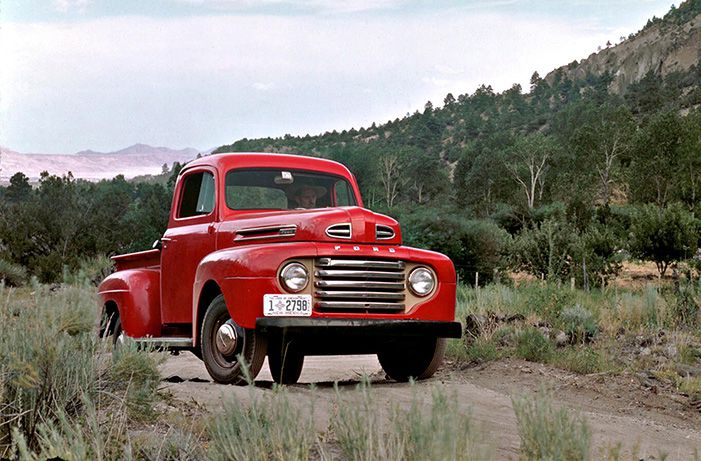No more than nine years after his creation of the famous Model T car, Henry Ford responded to the vehicle needs of farmers, tradespeople, and transporters with a small vehicle capable of carrying a 1 ton payload.
In true farm boy fashion, Ford created the Model TT truck, a vehicle retaining the Model T cab and engine (to save cost) but riding to work on a heavier-duty frame capable of carrying a 1 ton payload.
Introduced the same year as Ford’s first tractor, the Fordson, the Model TT followed the lead set by the tractor as being affordable to a fault with a factory price of just $600. Buyers responded, immediately snapping up 209 Model TTs in 1917.
Ford Motor Company
Just 11 years later, that figure skyrocketed to 1.3 million Model TTs on the road. Building on that success, Ford expanded his trucks’ capabilities by bringing out the Model AA 1 1⁄2 ton vehicle in 1928.
“Model AA trucks, in particular, had a certain class to them,” says Ford historian Bob Kreipke. “Customers could use them on the farm, yet take them to church on Sunday.”
To stay ahead in what had become a hotly competitive business, Ford replaced the Model AA with the even more capable Model BB in 1933. Two years later, Ford brought out the 1935 Model 50 pickup, powered exclusively by its famous Ford flat-head V-8 engine.
The War Intervenes
By 1941, Ford had sold more than 4 million trucks. World War II put the manufacture of pickups on hold in lieu of war material.
Ford Motor Company
A year after consumer production resumed in 1947, Ford leveraged its knowledge of producing war trucks to create more power vehicles for the public. Advertised as “Built Stronger to Last Longer,” the F-Series reflected America’s postwar economic prosperity. “After the war, a lot of rural Americans moved to urban and suburban centers looking for work, and many took their Ford pickups with them,” says Kreipke. “Ford saw this as an opportunity and began work on the next generation of trucks for 1948, what came to be known as F-Series Bonus Built trucks.”
The F-Series also reflected a much broader truck line now ranging from the 1⁄2-ton F-1 to the F-8 cab-over truck. The “F” designation was expanded in 1953 with the F-100, F-250, and F-350 pickups, while heavier trucks were designated as C-Series commercial vehicles.
Loyalty Begins at the Dealership
My father, Eldred, was a Ford man, especially when it came to pickup trucks. He didn’t really care about the big grain trucks. But for pickups, he was Ford through and through.
Truth be told, I don’t think Dad was as enamored with the vehicle’s manufacturer as much as he appreciated his local dealer. So much so, all our pickups and cars came from Workman Motors, the Ford dealer in Aurora, Nebraska. Workman didn’t sell grain trucks, so Dad didn’t care where they came from (we had Chevys, IHCs, Macks, and many other brands of big trucks).
My father’s preference for certain cars and pickups best illustrates the importance that dealerships hold when it comes to brand preference – whether that be pickup trucks or tractors. I often joke that some folks are so loyal to a certain brand, they wear underwear in the matching color.
Just like my dad and so many others, often, the first true commitment to a brand comes from dealer loyalty. — Dave Mowitz
The F-150 is Born
That year also marked expanded creature comforts in trucks such as automatic transmissions, improved heater and radio offerings, lower and wider cabs, plus aerodynamic design.
The fourth-generation F-Series was introduced in 1961. Then Ford’s innovative twin I-beam front suspension debuted in 1965. The pickup line was refined again two years later with power steering, power brakes, and a lower chassis profile.
Ford Motor Company
With the arrival of the sixth-generation F-Series in 1975, Ford dropped the popular F-100, replacing it with a higher-capacity F-150 pickup. The F-150 proved so popular that it helped catapult Ford to the No. 1 spot in pickups sales in 1977, a position the company hasn’t relinquished since that time.
Ford Motor Company
Built Ford Tough
“Built Ford Tough” came into the lexicon of pickup sales that same year. By 1977, F-Series trucks pulled ahead in the pickup sales race. Since that time, Ford has sold well over 26 million pickup trucks.
Ford Motor Company
Premium-edition trucks embellished with the Lariat trim package came out in 1978, offering more comfort features including air conditioning, leather trim, and power windows and locks. In 1982, Ford charted a different course with an all-new compact truck tabbed the Ranger. On the other hand, the firm realized a growing need for large-scale pickups, so it brought out the F-Series Super Duty line in 1998 with heavier-duty frames and higher-powered gas and diesel engines.
